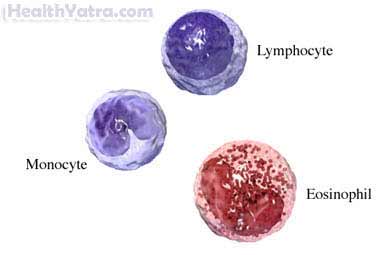تعريف
Eosinophils is a type of white blood cell. These white blood cells help to protect the body from infections. Eosinophils are created in the bone and move through the body in the blood.
Eosinophilia is an abnormally high number of these white blood cells. There may be high levels of eosinophils in the blood, in the tissue, or both. There are several types of eosinophilia based on the cause and symptoms.

أسباب
Eosinophilia may be caused by an injury or illness to a specific area or an overproduction of these cells. The cause will vary based on type of eosinophilia:
- Familial eosinophilia—caused by problems in genes that control eosinophil growth
- Secondary eosinophilia—related to an infection, autoimmune reaction, or other inflammatory illnesses
- Primary eosinophilia—change in production of eosinophils associated with certain leukemias or chronic myeloid disorders such as myelodysplastic syndrome
- Idiopathic eosinophilia—causes is not clear
عوامل الخطر
A family history increases your chance of familial eosinophilia.
Conditions that increase your chance of secondary eosinophilia include:
- Allergic rhinitis or hay fever
- Allergy to foods
- Dermatitis herpetiformis
- Vasculitis
- التعرض للسموم
- Prescription drug side effects
- Parasitic infection
- Cirrhosis of the liver
- الربو
- Inflammatory conditions such as scleroderma, polyarteritis, sarcoidosis, or inflammatory bowel disease
- الأكزيما
- Hodgkin’s lymphoma
- Non-Hodgkin’s lymphoma
Conditions that increase your chance of primary eosinophilia include:
- Acute myeloid leukemia
- Acute lymphocytic leukemia
- Myelodysplastic syndrome
الأعراض
Symptoms of eosinophilia are often those of the underlying condition. For example:
- Asthma symptoms may include:
- الصفير
- Breathlessness
- Parasitic infection symptoms may include:
- ألم في البطن
- إسهال
- حمى
- سعال
- Rashes
- Medicine reaction symptoms may include:
- Skin rashes
Rarer symptoms of eosinophilia may include:
- فقدان الوزن
- تعرق ليلي
- Lymph node enlargement
- Skin rashes
- Numbness and tingling due to nerve damage
التشخيص
Your doctor will ask about your symptoms and medical history. A physical exam will be done. You may be referred to a blood specialist.
Eosinophil levels maybe measured through:
- A blood test
- خزعة الجلد
Other tests will depend on the underlying condition. Your doctor may order:
- Blood test to measure antibody levels
- Stool examination
- الأشعة السينية الصدر
- CT scan of chest and abdomen
- Lung biopsy
- Bone marrow examination
- تنظير القصبات
العلاج
Talk with your doctor about the best treatment plan for you. Primary and secondary eosinophilia can be managed by treating the underlying cause.
Idiopathic eosinophilia may be treated with corticosteroids. This group of medications can reduce inflammation and decrease the number of eosinophils. Corticosteroids may be taken in inhaled form, topical treatment, pills, or injections.
الوقاية
Cause of eosinophilia is not always clear. As a result, there are no specific steps to prevent eosinophilia.
